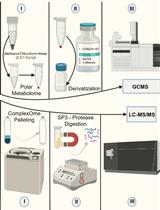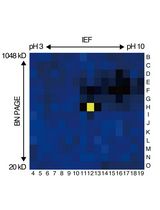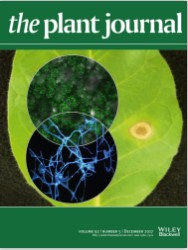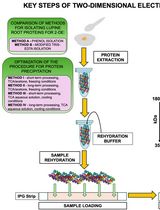- EN - English
- CN - 中文
Separation of Thylakoid Protein Complexes with Two-dimensional Native-PAGE
采用二维非变性PAGE分离类囊体蛋白复合物
发布: 2018年07月05日第8卷第13期 DOI: 10.21769/BioProtoc.2899 浏览次数: 10622
评审: Venkatasalam ShanmugabalajiShweta PanchalAnonymous reviewer(s)

相关实验方案

利用SP3珠和稳定同位素质谱技术优化蛋白质合成速率:植物核糖体的案例研究
Dione Gentry-Torfer [...] Federico Martinez-Seidel
2024年05月05日 2824 阅读

基于活性蛋白质组学和二维聚丙烯酰胺凝胶电泳(2D-PAGE)鉴定拟南芥细胞间隙液中的靶蛋白酶
Sayaka Matsui and Yoshikatsu Matsubayashi
2025年03月05日 1908 阅读
Abstract
The hierarchical composition and interactions of the labile thylakoid protein complexes can be assessed by sequential 2D-native gel-electrophoresis system. Mild non-ionic detergent digitonin is used to solubilize labile protein super-and megacomplexes, which are then separated with first-dimension blue native polyacrylamide gel electrophoresis (1D-BN-PAGE). The digitonin derived protein complexes are further solubilized with stronger detergent, β-DM, and subsequently separated on an orthogonal 2D-BN-PAGE to release smaller protein subcomplexes from the higher-order supercomplexes. Here we describe a detailed method for 2D-BN-PAGE analysis of thylakoid protein complexes from Arabidopsis thaliana.
Keywords: Native gel electrophoresis (非变性凝胶电泳)Background
Photosynthetic light reactions take place in the thylakoid membrane, which in higher plants is composed of appressed grana thylakoids and non-appressed stroma thylakoids. The light reactions are catalyzed by multi-subunit protein complexes photosystem (PS) I and II, cytochrome b6f and ATPase. PSII together with its light harvesting antenna complex (LHCII) is most abundant in grana-thylakoids and therefore spatially segregated from stroma thylakoid -located PSI-LHCI complexes (Andersson and Anderson, 1980). The interphase between the grana and stroma thylakoid is enriched in both photosystems (Albertsson, 2001; Suorsa et al., 2015). Mediated by light dependent reversible phosphorylation of LHCII and PSII proteins, the photosystems together with LHCII assemble into larger super- and megacomplexes. PSII core dimer together with two strongly and two moderately bound LHCII-trimers form large C2S2M2 supercomplexes, PSI together with loosely bound LHCII form PSI-LHCII supercomplexes, and finally, PSII and PSI together with L-LHCII form large PSII-LHCII-PSI megacomplexes (Caffarri et al., 2009; Pesaresi et al., 2009; Rantala et al., 2017).
Non-ionic detergents are generally used for isolation of native protein complexes from biological membranes. Mild detergent digitonin maintains weak interactions between protein complexes, but due to its bulky structure, it selectively solubilizes only the non-appressed regions of the thylakoids. However, when supplemented with low ionic strength salt, aminocaproic acid (ACA), digitonin gets access to the partition gap between two grana appressions and solubilizes the entire thylakoid membrane allowing the analysis of the overall organization of labile thylakoid protein complexes (Rantala et al., 2017). Solubilized protein complexes are supplemented with anionic Coomassie G-250 (CBB) dye that binds to the hydrophobic domains of protein complexes providing them with negative charge, and allows their electrophoretic separation according to molecular mass. Since the negative surface charges repel each other, CBB also prevents random protein complex aggregation.
Blue native PAGE (BN-PAGE) enables membrane protein complex separation in their native and functionally active form (Schägger and von Jagow, 1991). Coupling the 1D-BN-PAGE with a second (2D)-BN-PAGE allows the analysis of the subcomplex composition of the digitonin derived large protein super- and megacomplexes: The 1D-BN-gel lane containing the separated protein complexes is treated with slightly stronger detergent, n-dodecyl-β-D-maltoside (β-DM), which more effectively interferes with the interactions between protein complexes, particularly destroying the interaction of LHCII with the two photosystems. The lane is then subjected to the 2D-BN-PAGE for the separation of the dissociated subcomplexes. The composition of the subcomplexes can be further analyzed by electroblotting the 2D-gel and detecting specific proteins with antibodies or by cutting the lanes and subjecting the subcomplexes to denaturing 3D-SDS-PAGE.
This protocol describes optimized thylakoid protein complex isolation method and the analysis of the subcomplex composition of large protein super- and megacomplexes of Arabidopsis thaliana by 2D-BN-BN-PAGE. The method can be used for the analysis of the organization of the photosynthetic protein complexes and for the analysis of subcomplex composition of higher-order protein super- and megacomplexes.
Materials and Reagents
- Consumables
- Eppendorf microcentrifuge tubes 1.5 ml (Eppendorf, catalog number: 0030121694 )
- Falcon, Conical Centrifuge Tubes 15 ml (Corning, catalog number: 352096 )
- Culture tubes 5 ml (Lab Depot, catalog number: TLDT8301 )
- Finntip Pipette Tips (Finntip Flex 10, 250, 1,000 and 5 ml)
- Whatman chromatographic paper (GE Healthcare, catalog number: 1001-931 )
- PVDF membrane (Merck, catalog number: IPVH304F0 )
- Eppendorf microcentrifuge tubes 1.5 ml (Eppendorf, catalog number: 0030121694 )
- Plant material
Isolated thylakoids from 5-week old Arabidopsis thaliana (isolate thylakoids in the presence of 10 mM NaF in all buffers as described in Järvi et al., 2011) - Reagents
- 6-aminocaproic acid (Sigma-Aldrich, catalog number: A2504 )
- Bis-Tris (Sigma-Aldrich, catalog number: B4429 )
- Glycerol (Avantor Performance Materials, J.T. Baker, catalog number: 7044 )
- Pefabloc SC (4-(2-Aminoethyl) benzenesulfonyl fluoride hydrochloride) (Roche Diagnostics, catalog number: 11585916001 )
- Sodium Fluoride (NaF) (Avantor Performance Materials, J.T. Baker, catalog number: 3688 )
- EDTA disodium salt (Avantor Performance Materials, J.T. Baker, catalog number: 1073 )
- Digitonin (Merck, Calbiochem, catalog number: 300410 )
- n-dodecyl-β-D-maltoside (Sigma-Aldrich, catalog number: D4641 )
- Serva Coomassie Blue G (SERVA Electrophoresis, catalog number: 35050 )
- Sucrose (Sigma-Aldrich, catalog number: S0389 )
- Tricine (Sigma-Aldrich, catalog number: T0377 )
- TEMED (Tetramethylethylenediamine) (Bio-Rad Laboratories, catalog number: 1610801 )
- Liquid nitrogen
- Methanol (VWR)
- Bovine Serum Albumin (BSA) (Sigma-Aldrich, catalog number: A7030 )
- Acrylamide (AA) (Sigma-Aldrich, catalog number: A9099 )
- (N,N'-Methylene)-Bis-Acrylamide (Bis-AA) (Merck, Omnipur, catalog number: 2610 )
- APS (Ammonium persulfate) (Bio-Rad Laboratories, catalog number: 1610700 )
- Tris (Sigma-Aldrich, catalog number: T1503 )
- Glycine (Fisher Scientific, catalog number: 10070150 )
- SDS (VWR, catalog number: 442444H )
- 6-aminocaproic acid (Sigma-Aldrich, catalog number: A2504 )
- Antibodies
- Stock solutions
- Acrylamide solution A: 48% (w/v), 1.5% (w/v) Bis-acrylamide in MQ-water, store at 4 °C
- Acrylamide solution B: 20% (w/v), 5% (w/v) Bis-acrylamide in MQ-water, store at 4 °C
- APS (Ammonium persulfate): 5% (w/v) solution in MQ-water, store at 4 °C
- Digitonin stock solution: 10% (w/v) in MQ-water, store at -20 °C
- β-dodecyl maltoside: 10% (w/v) in MQ-water, store at -20 °C
- Glycerol: 75% (w/v) solution in MQ-water, store at 4 °C
- Pefabloc: 10 mg/ml (w/v) in MQ-water, store at -20 °C
- Sucrose: 75% (w/v) in MQ-water, store at -20 °C
- Acrylamide solution A: 48% (w/v), 1.5% (w/v) Bis-acrylamide in MQ-water, store at 4 °C
- Buffers
- 3x Gel Buffer, store at 4 °C (see Recipes)
- 25BTH20G resuspension buffer, prepare fresh (see Recipes)
- ACA buffer (see Recipes)
- Detergent buffer A (4% Digitonin), prepare fresh (see Recipes)
- Detergent buffer B (1% β-DM), prepare fresh (see Recipes)
- CBB buffer, -20 °C (see Recipes)
- Anode buffer for BN, store at 4 °C (see Recipes)
- Blue cathode buffer for BN, store at 4 °C (see Recipes)
- Clear cathode buffer for BN, store at 4 °C (see Recipes)
- Transfer buffer, store at 4 °C (see Recipes)
- BN-PA: 3.5-12.5% separation gel, 3% stacking gel (see Recipes)
- 3x Gel Buffer, store at 4 °C (see Recipes)
Equipment
- Dual gel caster with 10 x 8 cm plates (Hoefer, catalog number: SE215 )
- Hoefer gradient maker SG5 (or any gradient maker containing two 5 ml chambers)
- 0.75 mm T-spacers (Hoefer, catalog number: SE2119T-2-.75 )
- 1 mm T-spacers (Hoefer, catalog number: SE2119T-2-1.0 )
- Sample gel comb, 0.75 mm, 10 wells (Hoefer, catalog number: SE211A-10-.75 )
- 2D comb (flat) with a reference well, 1.0 mm thick
- Mighty Small SE250 vertical electrophoresis system (Hoefer, catalog number: SE250 )
- Ismatec IPC-pump
- Power supply, PowerPac HV (Bio-Rad Laboratories, catalog number: 164-5056 )
- Centrifuge (Eppendorf, model: 5424R )
- FinnpipetteTM F2 Variable Volume Single-Channel Pipettes
- Cold room (4 °C)
- Freezer (-20 °C)
- Photo scanner (e.g., Perfection V300 Photo, Epson, model: V300 )
- Rocker-Shaker (Biosan, model: MR-12, catalog number: BS-010130-AAI )
- Semi-dry blotting system (Hoefer, catalog number: TE77X )
Procedure
文章信息
版权信息
© 2018 The Authors; exclusive licensee Bio-protocol LLC.
如何引用
Rantala, M., Paakkarinen, V. and Aro, E. (2018). Separation of Thylakoid Protein Complexes with Two-dimensional Native-PAGE. Bio-protocol 8(13): e2899. DOI: 10.21769/BioProtoc.2899.
分类
植物科学 > 植物分子生物学 > 蛋白质
植物科学 > 植物生物化学 > 蛋白质 > 分离和纯化
分子生物学 > 蛋白质 > 蛋白质-蛋白质相互作用
您对这篇实验方法有问题吗?
在此处发布您的问题,我们将邀请本文作者来回答。同时,我们会将您的问题发布到Bio-protocol Exchange,以便寻求社区成员的帮助。
Share
Bluesky
X
Copy link











